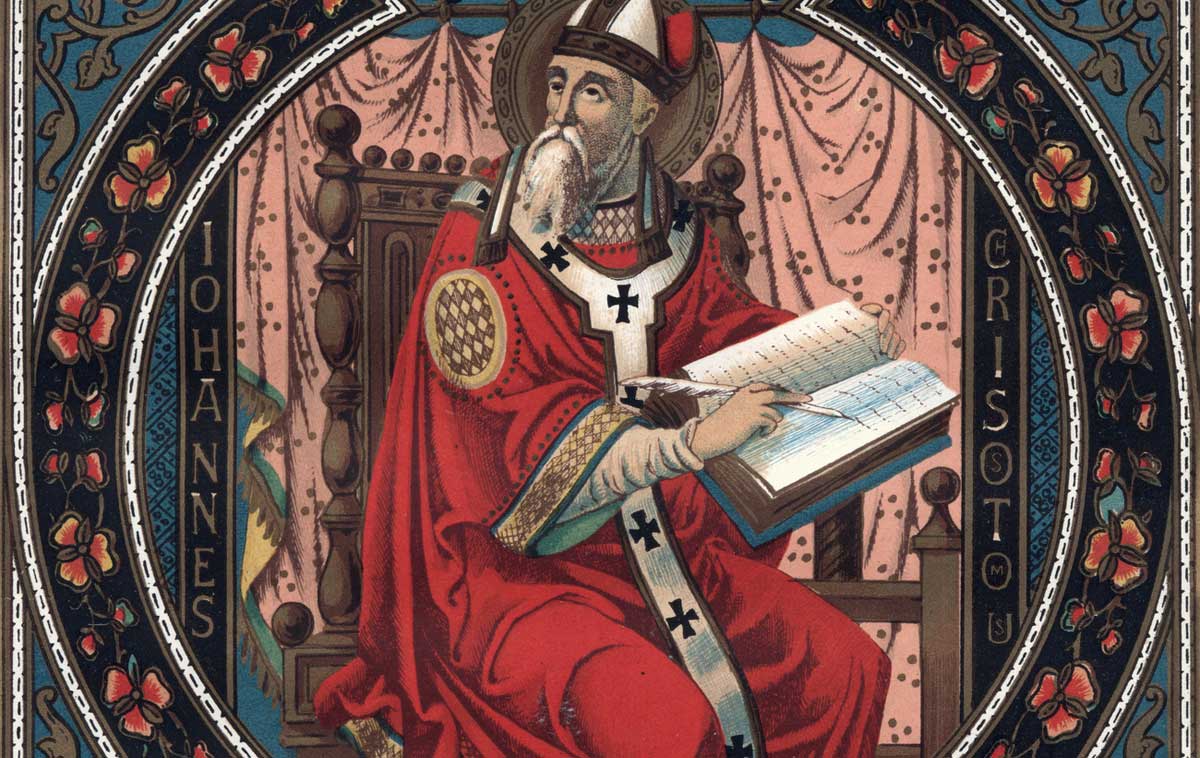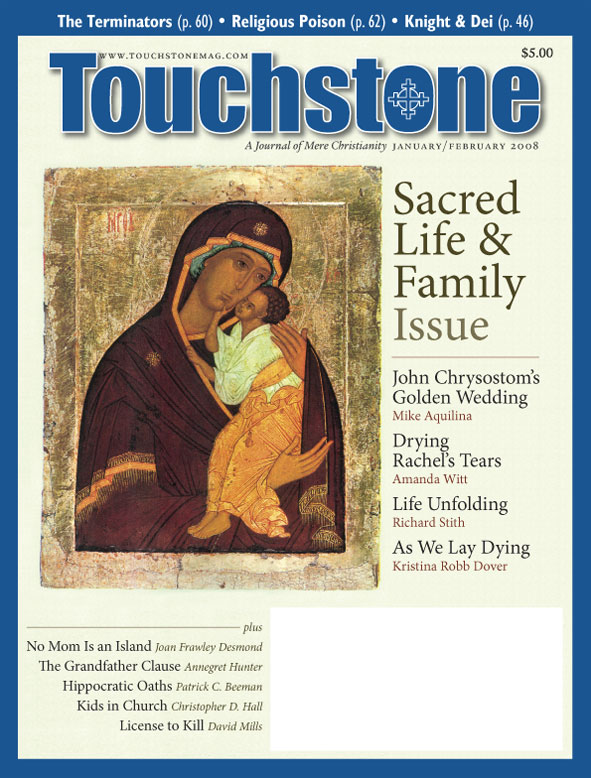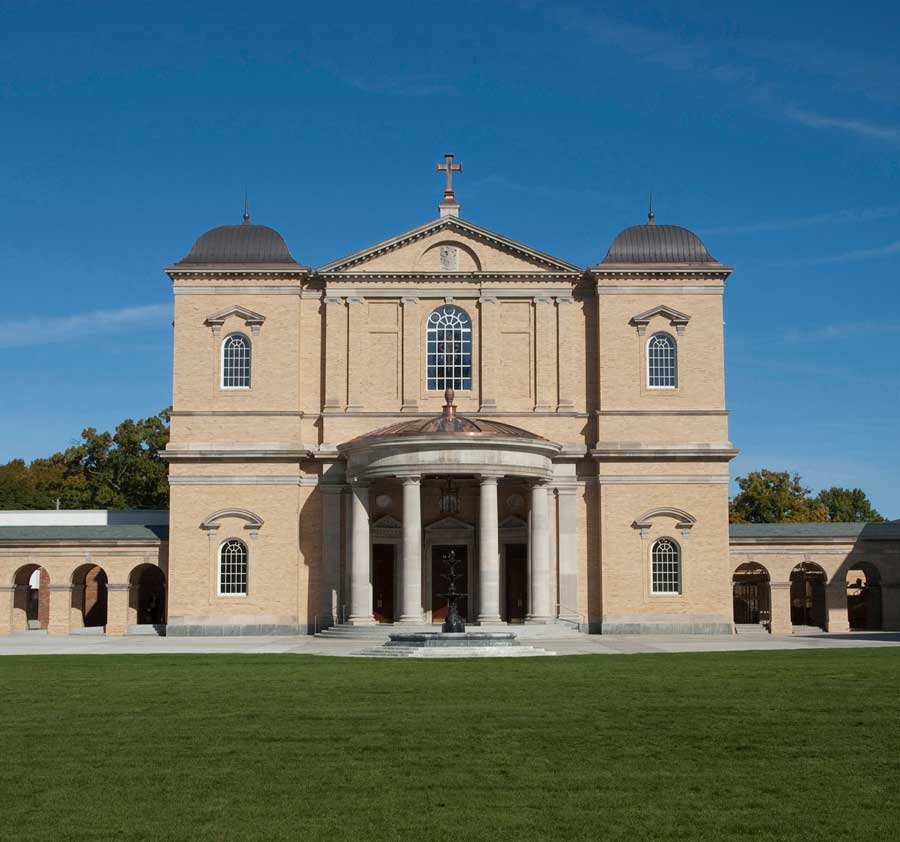Feature
One Flesh of Purest Gold
John Chrysostom’s Discovery of the Blessings & Mysteries of Marriage
When a man publishes so much—we have some 700 sermons and 246 letters of St. John Chrysostom’s, plus biblical commentaries, moral discourses, and theological treatises—an industrious enemy can pull together enough strands to make a strong rope for his hanging. On the subject of marriage, John made it easy for his enemies.
When libertines want to caricature Christian teaching, they inevitably quote Chrysostom. One anti-Christian website produces this gem from one of his homilies: “It does not profit a man to marry. For what is a woman but an enemy of friendship, an inescapable punishment, a necessary evil, a natural temptation, a domestic danger, delectable mischief, a fault in nature, painted with beautiful colors?” Even so great a historian as Peter Brown found Chrysostom’s vision of sexuality to be “anxious” and “bleak.”
Yet John is the Father most invoked by those who wish to exalt the Christian vision of marriage. The Orthodox theologian Vigen Guroian speaks of “Chrysostom’s virtually unique contribution” to a positive Christian understanding of family life.
He quotes John’s famous description of lovemaking: “How do they become one flesh? As if she were gold receiving purest gold, the woman receives the man’s seed with rich pleasure, and within her it is nourished, cherished, and refined. It is mingled with her own substance and she then returns it as a child!”
A necessary evil, gold receiving gold. . . . How do we reconcile these two sides of Chrysostom? Do we dismiss him as a hypocrite or a clericalist who held married people to a lower standard than monks?
No. Both quotations—the harangue and the poetry—make sense in the context of John’s life.
A Monastic Home
St. John was born in Antioch around A.D. 349. His father, a high-ranking civil servant named Secundus, died shortly after his birth, leaving his wife Anthousa a widow at age twenty. She could have remarried but chose to follow the biblical counsel “to the unmarried and the widows . . . to remain single” (1 Cor. 7:8), enrolling in the Church’s order of widows and committing herself to a life of prayer, continence, and service.
Anthousa’s piety made a deep impression on young John. He also lived with an aunt, Sabiniana, who served the Church of Antioch as a deaconess. Her contemporaries tell us that she “conversed intimately with God.” Needless to say, John grew up in an unusual, almost monastic, household.
He seemed destined to be a civil servant like his father, but after graduation he and a friend decided to form a “brotherhood,” a household sharing a common life of voluntary poverty, prayer, and contemplation. They had gone far with their plans when John broke the news to his mother.
And she hit the roof. She begged him not to make her a widow all over again. He could not resist her pleading, so he agreed to pursue his life of renunciation at home. He adopted the dress of monks, a coarse, sleeveless garment, took up Scripture study under a renowned master, and applied himself in service to the bishop of Antioch.
After three years, he managed to break free and join the solitaries in the wilderness nearby. He read the Scriptures for hours each day until he had memorized entire books.
He lived in a cave by himself. He did not permit himself to lie down, by day or night. He slept hardly at all, and went without protection from the heat and cold. His diet was wretched. So zealous was he that he continued even after his health began to fail. After two years, he could go on no longer. He needed medical care. So he returned, disappointed, to the city.
About this time, one of his fellows in the ascetic life, Theodore, began having second thoughts. His folks needed him to run the family business. And there was a young woman beckoning, too. Her name was Hermione. He erased his name from the rolls of the brotherhood and went home.
A Furious Friend
The situation demanded a response from John, and respond he did. His response has come down to us with the title Letter to Theodore After His Fall. We have it in two parts, totaling 24,000 words—the words of a furious man shaking his friend by the lapels.
It is an evil thing to wed a very poor wife, or a very rich one; for the former is injurious to the husband’s means, the latter to his authority and independence. It is a grievous thing to have children, still more grievous not to have any. . . . Is this then life, Theodore, when one’s soul is distracted in so many directions, when a man has to serve so many, to live for so many, and never for himself?
John’s rhetoric boils over as he tries to show the transitory nature of bodily beauty and the grossness of its parts. Hermione may be beautiful, but “the groundwork of this bodily beauty is nothing but phlegm, blood, rheum, bile, and the fluid of digested food.” Consider, he continues, “what is stored inside those beautiful eyes, that straight nose, and the mouth and cheeks, and you will affirm the well-shaped body to be nothing but a whited sepulcher; the parts within are full of so much uncleanness.”
John goes on to compare such illusory and passing beauty with the true and lasting beauty of the soul of a monk steeped in prayer. Needless to say, the earthly beauty comes up the loser.
He is careful to acknowledge that marriage is an honorable estate, citing Hebrews 13:4, but insists it cannot be honorable for Theodore. “It is no longer possible for you to observe the right conditions of marriage. For if he who has been attached to a heavenly bridegroom deserts him and joins himself to a wife, the act is . . . worse than adultery in proportion as God is greater than man.”
For these passages, John has been vilified by secularists, feminists, and hedonists. But I’d like to plead his case. He was, after all, operating in crisis mode. His friend had already gone back on a lifelong commitment, checked himself out of the holy brotherhood. Theodore was breaking a promise he had made to God. John recognized this as an emergency demanding forceful intervention.
So he used his rhetoric the way some men might use their muscles. And he succeeded in talking Theodore back to the brotherhood. Theodore would go on to become one of the most influential theologians in antiquity, the celebrated theologian-bishop of Mopsuestia.
We should also recognize that John probably had, at this point, only the remotest experience of normal family life. His father died when he was an infant, and his mother’s household was practically monastic. After this extraordinary upbringing, he joined the mountain solitaries.
I am not saying that his upbringing was warped or harmful, nor am I sneering at his formation by the hermits. Both periods gave him the discipline he would need to withstand the hardships of his later life. But they were unusual circumstances, and they hardly equipped him for a realistic view of domestic life.
But that, too, would come with time.
A Marital Path
John wrote his negative statements about marriage when he was young and inexperienced. As he entered the bustling life of the Church of Antioch, however, he encountered many families, real families, ordinary families, Christian families. He shared their life. He counseled them.
And he grew to consider marriage not as a concession to weakness or a second-class citizenship in the Church, but as a distinct vocation from God and a path to holiness. Even more, he came to see it as a powerful image of God in the world: a sacrament of God.
But, again, that came only with time and experience. In 381 he was ordained a deacon and licensed to preach. It was then that he earned the nickname Chrysostom (Golden Mouth), as he drew enormous crowds to church. After five years as a deacon, he was ordained to the priesthood.
Another several years passed before John preached the first of the sermons in which we find his mature teaching on marriage: his homilies on First Corinthians. A few years later, he would return to the same themes in his homilies on Ephesians and Colossians and his sermons on vainglory. That first decade of his priesthood was a time of intense pastoral work in the second city of the empire.
In a moving expression of his love, he told his congregation: “I know no other life but you and the care of souls.” And what did he learn from all that work with all those souls? “There is nothing that so welds our life together as the love of a man and his wife,” and “There is nothing in the world sweeter for a man than having children and a wife.”
In that first decade of priesthood, John came to see that Christian marriage was as much a divine vocation as monasticism and that Christian perfection was, by God’s grace, attainable in marriage. Indeed, he laments to his people “that you think that monks are the only persons properly concerned with decency and chastity.”
In the strongest terms, he assures his congregation that their calling is nothing less than perfection. He says: “If the beatitudes were spoken only to solitaries, and the secular person cannot fulfill them, yet [Jesus] permitted marriage anyway—then all things have perished, and Christian virtue is boxed in.”
But that cannot be true, and so he continues: “If persons have been hindered by their marriage state, let them know that marriage is not the hindrance, but rather their intentions, which made an ill use of marriage.”
Opened Eyes
What caused John’s change of heart? Had he grown worldly, as pastors sometimes do, concerned as they are with budgets and leaky roofs? No. He continued to live by all the monastic disciplines, including fairly rigorous fasting, and always took his meager meals alone.
I believe that John grew deeper in his appreciation for marriage as he grew in the work of Christian initiation—as he taught group after group of new Christians to appreciate the radical transformation God was working in their lives. In a city like Antioch in the late fourth century, a pastor could prepare hundreds of adult converts every year. He would lead them to the mysteries, and he would tell them of the mysteries. In baptism God would give them new eyes of faith, and John would teach them to open those eyes.
This is what the Church calls mystagogy: the doctrine of the mysteries, guidance in things hidden since the foundation of the world (see Matt. 13:35). These were often, in the ancient Church, taught in daily homilies through the eight days after Easter that revealed doctrines that had been kept hidden: the Real Presence of Jesus in the Eucharist and the deifying grace of baptism.
The mystagogue guides the new Christian through the external, material appearances to the unseen reality that is interior, spiritual, hidden, and divine. As John told his class of new Christians: “What is performed here requires faith and the eyes of the soul: we are not merely to notice what is seen, but to go from this to imagine what cannot be seen. Such is the power of the eyes of faith. . . . For faith is the capacity to attend to the invisible as if it were visible.”
A mystagogical quality pervades John’s works. We see it in his homilies on the Letter to the Hebrews and his treatise on the priesthood. And, I contend, it is the principle that gives life to his mature doctrine of marriage.
We could honestly and accurately describe it as a mystagogy of marriage. He wants us to move from the icon to the reality. Still, he insists that we must also learn to venerate the icon. “Learn the power of the type,” he says, “so that you may learn the strength of the truth.”
It is important for us to realize that John’s mature doctrine of marriage is almost unique in ancient Christianity. His contemporaries tended to look upon marriage as an institution that was passing away, as more and more Christians turned to celibacy. The best thing Jerome could say about marriage was that it produced future celibates. In Antioch in John’s day, there were 3,000 consecrated virgins and widows in a city of perhaps 250,000, and that number does not include the celibate men in brotherhoods or the hermits who filled the nearby mountains.
Yet John glorified marriage. It pained him that Christian couples continued to practice the old, obscene pagan wedding customs. So shameful were these practices that few couples dared to invite their parish priest to attend and give a blessing.
“Is the wedding then a theater?” he told them in a sermon. “It is a sacrament, a mystery, and a model of the Church of Christ. . . . They dance at pagan ceremonies; but at ours, silence and decorum should prevail, respect and modesty. Here a great mystery is accomplished.”
A Biblical Mystery
This is the language of mystagogy. John is guiding us through the mystery of marriage.
His mystagogy of marriage was unusual in his day, but it had deep biblical roots. John grounded his doctrine firmly in St. Paul’s Letter to the Ephesians 5:31–32: “For this reason a man shall leave his father and mother and be joined to his wife, and the two shall become one flesh. This mystery is a profound one, and I am saying that it refers to Christ and the Church.”
Paul is drawing from the first chapters of Genesis. Indeed, any preacher who memorized most of the Scriptures, as John did, would notice that marriage is a dominant theme in both the Old and New Testaments. The Bible begins with a wedding—of Adam and Eve—and ends with a wedding: the marriage supper of the Lamb. And in between, God, speaking through the prophets, repeatedly invokes marriage as the preeminent symbol of his covenant.
For John, marriage is both an image of baptism, where the believer is wed to Christ, and an image of the Eucharist, which makes “one flesh” of the believer and Christ. He tells the new Christians to “keep the marriage robe in its integrity, that with it you may enter forever into this spiritual marriage.”
Marriage, moreover, is an icon of the Trinity. “The child is a bridge connecting mother to father, so the three become one flesh. . . . And here the bridge is formed from the substance of each!” That, he continues,
is why Scripture does not say, “They shall be one flesh.” But they shall be joined together “into one flesh,” namely the child. But suppose there is no child; do they then remain two and not one? No: their intercourse effects the joining of their bodies, and they are made one, just as when perfume is mixed with ointment.
At that point, he must have looked out at a congregation full of people fanning themselves and averting their eyes, because he was moved to cry out,
Why are you blushing? Leave that to the heretics and pagans, with their impure and immodest customs. For this reason I want marriage to be thoroughly purified, to bring it back again to its proper nobility. You should not be ashamed of these things. If you are ashamed, then you condemn God who made marriage. So I shall tell you how marriage is a mystery of the Church!
John did not want us to blush at the mention of married love. But, most of all, he wanted us to have no reason to blush.
Among all the ancient mystagogues, John stands out for his unique emphasis on morals. He insists that the sacraments should leave their mark on everything we do. The sacraments have consequences for every moment of every day.
Through baptism and the Eucharist, we become “partakers of the divine nature” (2 Pet. 1:4). John would have us, then, live our marriages purely, as Christ lives his.
And John speaks plainly. He does not care if he makes parishioners squirm. None of the Fathers preached as frankly as John did on sexual matters.
What did this mean, practically? He repeatedly condemns contraception as unworthy of Christian marriage and calls it preemptive murder. “Why do you sow where the field is eager to destroy the fruit?” he asks.
Where there are medicines of sterility? Where there is murder before birth? Indeed, it is something worse than murder and I do not know what to call it; for she does not kill what is formed but prevents its formation. What then? Do you despise the gift of God, and fight with his law?
John saw contraception as a violation of the type, a desecration of the icon, a defiling of the sacrament. If marriage is a sacrament of God, then it should be a true communion and truly fruitful, as God is.
John also condemned adultery, domestic violence, sodomy, abortion, divorce, and other acts that are unworthy of the sacrament of Jesus Christ and his Church.
Humbled & Exalted
John learned to love marriage. As a celibate, he lost nothing in the bargain. For renouncing something second-rate is no big deal. But renouncing something so great as Holy Matrimony—a sign of the Trinity—in order to live with the Trinity even now as an angel in heaven, renouncing the sign in order to possess the Signified, increases the value of celibacy by orders of magnitude.
As John himself said, denigrating marriage “diminishes the glory of virginity” and praising it “makes virginity more admirable and resplendent. What appears good only in comparison with evil would not be particularly good. It is something better than what is admitted to be good that is the most excellent good.”
Marriage cannot get any better than St. John Chrysostom, in his mature years, made it out to be. For a married man or woman to read his homilies on Colossians and Ephesians is to be simultaneously humbled and exalted. Humbled because we must confront our own sin, our own clinging to the mud of this earth. Exalted because God has lifted us up so high. •
The quotes from St. John are taken from: On Colossians 12.5; Letter to Theodore 2.5, 1.14; 2.3; On the Statues 1; On Ephesians 20.1; On Matthew 37.7; On Matthew 7.8; On Hebrews 7.11; Baptismal Homilies 2 (see also Baptismal Instructions 11.11), 3.13; On Colossians 12.5; Baptismal Instructions 6.24; On Colossians 12.5; ibid.; On Romans 24 (see also On Matthew 28.5; On Galatians 5.12; On Ephesians 5); On Virginity 10. The quote from Guroian is taken from his “The Ecclesial Family” in The Child in Christian Thought.
A Culture Exposed
A couple of years ago, the Washington Post ran an astonishing opinion column, written by one of its own. Patricia E. Bauer, a former Post bureau chief, has a grown daughter with Down syndrome, and she wrote about the rudeness she endured through the years.
People asked her whether she had undergone prenatal testing. The unspoken assumption was that, if she had, her daughter Margaret would never have been born. One Ivy League ethicist said in her presence that mothers whose unborn children test positive for Down syndrome have a “moral obligation” to terminate the pregnancy.
We’ve come a long way, baby. And we’ve ended up back where we started before the rise of Christianity. In the Church’s infancy, abortion and infanticide were commonplace events, requiring little deliberation.
Archeology has yielded us a rare glimpse at the inner life of ordinary people in this time. We have a letter from a pagan businessman in which he wrote home to his pregnant wife, amid the usual endearments: “If you are delivered of a child [before I come home], if it is a boy, keep it, if a girl discard it.” (In one city of the empire, the census enrolled 600 families—of which only six had raised more than one daughter.)
Indeed, most cultures considered it a duty to place “defective” newborns on the dunghills at the edge of town, where birds of prey could pick them apart. Most families interpreted the word “defective” broadly, to include female children as well as those with disabilities or disfigurement. Plato and Aristotle commended the practice, and the Roman historian Tacitus said it was “sinister and revolting” for Jews to forbid infanticide.
Yet these practices created a crisis for pagans. Abortion and infanticide led to low fertility rates, high maternal mortality, a shortage of marriageable women, and an absence of familial care for the elderly. Over generations, the dwindling native population of Rome grew increasingly dependent on foreign mercenaries to fill the ranks of the army, and on immigrants to do the servile jobs that no Roman citizen wanted to do.
That makes for an unstable social infrastructure. Various emperors tried to legislate fertility, but the law isn’t much of an aphrodisiac. Abortion kills a couple’s love every bit as much as it kills their baby. And besides, people had grown accustomed to an unmoored, leisurely life, drifting from pleasure to pleasure, without the encumbrance of children.
We face a similar crisis today. Christianity’s critics say they want to promote a tolerant, welcoming, inclusive society. What they usually mean is a society that gives free rein to vice, lust, and sin. But a growing number of people are dissatisfied with the societal consequences of those sins. What’s a culture to do?
We Christians have answers. Around A.D. 155, St. Justin Martyr wrote to the emperor: “We have been taught that it is wicked to expose even newly born children. . . . For we would then be murderers.” In the same century, Athenagoras said: “Women who use drugs to bring on an abortion commit murder.” And these testimonies appeared a century after the earliest recorded Christian condemnation of abortion.
Christians created the first truly tolerant, welcoming, and all-inclusive society—with a remarkable social-welfare system. They did this because they, unlike their rulers, not only tolerated the poor and weak, and even loved them with a human affection, but saw the least of the human family as the image of God, as Christ who must be welcomed, as angels requiring hospitality. The Didascalia Apostolorum decreed: “Widows and orphans are to be revered like the altar.”
From such reverence for life came true social security, true stability, and prosperity. From such reverence came many beloved and loving children like Margaret.
—Mike Aquilina
Mike Aquilina is vice president of the St. Paul Center for Biblical Theology (www.salvationhistory.com) and a general editor of The Catholic Vision of Love catechetical series.
subscription options
Order
Print/Online Subscription

Get six issues (one year) of Touchstone PLUS full online access including pdf downloads for only $39.95. That's only $3.34 per month!
Order
Online Only
Subscription

Get a one-year full-access subscription to the Touchstone online archives for only $19.95. That's only $1.66 per month!
bulk subscriptions
Order Touchstone subscriptions in bulk and save $10 per sub! Each subscription includes 6 issues of Touchstone plus full online access to touchstonemag.com—including archives, videos, and pdf downloads of recent issues for only $29.95 each! Great for churches or study groups.
Transactions will be processed on a secure server.
more on marriage from the online archives
more from the online archives
calling all readers
Please Donate
"There are magazines worth reading but few worth saving . . . Touchstone is just such a magazine."
—Alice von Hildebrand
"Here we do not concede one square millimeter of territory to falsehood, folly, contemporary sentimentality, or fashion. We speak the truth, and let God be our judge. . . . Touchstone is the one committedly Christian conservative journal."
—Anthony Esolen, Touchstone senior editor













